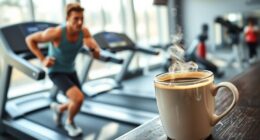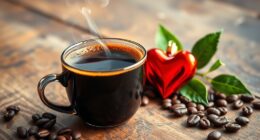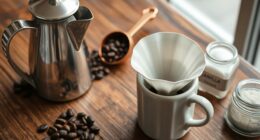To enjoy a delicious cup from your Bunn Coffee Maker, make sure to have a spotless brew funnel and use the correct filter. Ensure the brew funnel and carafe are in the right place, adhere to the specific instructions for your model, and always keep the water reservoir full to ensure a consistent brew. Simply press the brew button and savor the delightful flavors and scents in your coffee. Don’t forget that consistent cleanliness is crucial. Find more helpful tips for achieving the best brew, such as adjusting the brew temperature according to your preference. If your coffee tastes weak, try raising the brew temperature; if it’s too bitter, lower the temperature. Experiment with different settings until you discover the perfect brew for you, and make sure to regularly clean and maintain your Bunn Coffee Maker for peak performance. Want to enhance your coffee experience? Keep reading to find out how!
Key Takeaways
- Clean brew funnel and use Bunn filter for optimal brewing.
- Position funnel and carafe correctly for smooth operation.
- Follow specific brewing instructions for your Bunn model.
- Maintain water reservoir for consistent water supply.
- Initiate brewing by pressing the brew button.
Axiom Series Brewers
To brew coffee using the Axiom Series Brewers, follow these steps for a perfect cup every time:
- Make sure the brew funnel is clean and empty before starting.
- Use a Bunn filter in the brew funnel to ensure ideal brewing.
- Pour fresh coffee grounds into the filter for a flavorful brew.
- Securely insert the brew funnel into the rails to avoid mishaps during brewing.
- Place a clean carafe under the funnel to catch the freshly brewed coffee.
VPR & VPS Series Brewers

For brewing with the VPR & VPS Series Brewers, make certain a Bunn filter is placed in the brew funnel before adding fresh coffee grounds. Insert the brew funnel into the rails of the brewer and follow these steps:
- Open the flip top lid and pour water into the water reservoir.
- Confirm a clean pot is placed under the brew funnel to collect the brewed coffee.
- Start the brewing process according to the specific instructions for the VPR or VPS Series Brewers.
Using Commercial Bunn Coffee makers like the VPR & VPS Series Brewers can simplify the process of making a delicious pot of coffee.
With the brew funnel properly set up and the water reservoir filled, you're all set to enjoy a fresh brew.
Following these steps will secure that your Commercial Bunn Coffee maker runs smoothly, providing you with a satisfying coffee experience.
CDBC & CDBF Series Brewers

Place a Bunn filter in the brew funnel and add fresh coffee grounds when using the CDBC & CDBF Series Brewers.
Confirm the water reservoir is filled with cold water and the coffee pot is ready.
Insert the brew funnel into the rails of your Bunn coffee machine and position a clean carafe under the funnel to collect the brewed coffee.
Slide the empty brew funnel into the machine, making sure it fits securely.
Press the ON/OFF switch, then the BREW switch to kickstart the brewing process.
Once the brewing is complete, enjoy a delicious cup of coffee from your CDBC or CDBF Series Bunn Coffee Maker.
Remember to clean the machine thoroughly after each use to maintain its performance and longevity.
Brewing with your Bunn machine is a simple and satisfying experience with the CDBC & CDBF Series Brewers.
Subscribe Today

Sign up today to stay informed with the latest resource news from Parts Town by subscribing to our email updates. By entering your email address, you can make certain that you receive important updates and information about Bunn coffee makers.
Here are some key benefits of subscribing:
- Valuable Insights: Get tips on preventative maintenance to keep your Bunn coffee maker running smoothly.
- Quick Parts Acquisition: Stay updated on how to efficiently acquire parts for your Bunn coffee maker.
- Faster Delivery: Set your location for expedited parts delivery and check local inventory availability to get your coffee maker up and running in no time.
Subscribing to Parts Town's email updates won't only keep you informed about Bunn coffee makers but also provide you with essential knowledge on maintenance, parts acquisition, and delivery options.
Don't miss out on the opportunity to stay ahead with the latest information in the world of coffee makers.
Featured Resources

Explore the newest featured resources to enhance your knowledge and maximize the performance of your commercial Bunn coffee maker. With preventive maintenance, you can extend the lifespan of your Bunn coffee maker by taking proactive care measures.
Parts In Town provides access to genuine parts for your Bunn coffee maker, guaranteeing quick and efficient replacements when needed. By setting your location, you can benefit from rapid parts delivery and check local inventory availability for immediate access to essential components.
Stay updated on resource news from Parts Town to remain informed about the latest developments and maintenance tips for your commercial equipment. Additionally, simplify your future orders by logging in to your Parts Town account, where you can save account details, access order history, and streamline transactions seamlessly.
Utilize these featured resources to keep your Bunn coffee maker in peak condition and ensure uninterrupted brewing performance.
Why Log In?

When logging in to your account, you gain access to various benefits that streamline your ordering process and guarantee efficient transactions. By utilizing your account, you can benefit from:
- Access to Discounts or Contract Pricing: Logging in allows you to view special discounts and contract pricing tailored to your account, helping you save on your purchases.
- Saved Information for Faster Transactions: Keep your payment information, shipping addresses, and order history stored securely for quick and easy checkout on future orders.
- Equipment Details at Your Fingertips: Access and update your equipment details anytime, making sure you have the necessary information for maintenance and ordering parts.
Logging in not only simplifies the ordering process but also gives you the advantage of being able to fill your cart with the Parts In Town logo securely.
Take advantage of these features to make sure a smoother and more convenient experience when shopping for your coffee maker needs.
Components of a Bunn Coffee Maker

As you prepare to use your Bunn Coffee Maker, it's important to understand the key components that make up this brewing marvel.
The brewer funnel lid, internal hot water tank, glass carafe, and warmer plate all play vital roles in delivering that perfect cup of coffee.
Get familiar with these parts to guarantee a smooth and delicious brewing experience every time.
Bunn Coffee Maker Parts
You'll find that a commercial Bunn coffee maker comprises necessary components such as a brewer funnel cover, internal hot water reservoir, glass carafe cover (for GR, BX, NHS models), glass carafe (for GR, BX, NHS models), and a warmer plate (for all three models). These parts work together seamlessly to brew a delicious pot of coffee for you to enjoy.
The brewer funnel cover aids in directing the flow of water and coffee grounds during the brewing process.
The internal hot water reservoir guarantees that the water is heated to the proper temperature for brewing.
The glass carafe and cover are necessary for serving and storing the brewed coffee.
Lastly, the warmer plate maintains the coffee in the carafe hot and ready to serve.
Each component plays an important role in the coffee-making process, ensuring that you get a perfect cup every time.
Understanding Brewer Components
To comprehend the mechanics of a Bunn Coffee Maker, familiarize yourself with its essential brewer components. The Bunn coffee maker consists of real parts that work together to brew your perfect cup of coffee.
The cold water reservoir, found at the back of the machine, needs to be filled with cold water to guarantee a fresh brew. The empty brew funnel is where you place your coffee grounds for brewing. The Parts catalog can help you identify these components for any maintenance needs.
Once the cold water reservoir is filled, place the coffee pot with cold water on the warmer plate. This triggers the brewing process. The internal hot water tank then heats the water to the ideal temperature for brewing.
Understanding these brewer components will allow you to effectively operate your Bunn coffee maker and enjoy a delicious cup of coffee whenever you desire.
Steps to Brew With Bunn

Start by placing a Bunn filter in the brew funnel before adding fresh coffee grounds.
Insert the brew funnel into the rails of the Bunn coffee maker.
Position a clean carafe under the brew funnel to collect the brewed coffee.
To brew with a Bunn coffee maker, add water to the water reservoir, ensuring it's filled to the appropriate level for your desired amount of coffee.
Following the specific instructions for your Bunn model is essential to achieving a perfect cup of coffee.
Once everything is set up, simply press the brew button and let the machine work its magic.
The water will heat up and drip through the coffee grounds, extracting the rich flavors and aromas.
Soon enough, you'll have a delicious pot of coffee ready to be enjoyed.
Remember to clean the brew funnel and carafe after each use to maintain the quality of your brews.
Frequently Asked Questions
How Do You Operate a Bunn Coffee Maker?
To operate a Bunn coffee maker, make sure the brew funnel is clean, add a filter, pour fresh coffee grounds, secure the funnel, and place a carafe below. Follow these steps for a perfect brew every time.
What Is the Coffee to Water Ratio for a Bunn Coffee Maker?
To get the best brew from your Bunn coffee maker, aim for a coffee to water ratio of 1 ounce of grounds per 16 ounces of water. Adjust to suit your taste. Find that perfect balance for your morning cup!
How Do I Tell if My Bunn Coffee Maker Is On?
To know if your Bunn coffee maker is on, check for the power indicator light, feel the warmth of the heating plate, listen for water heating, feel the sides for warmth, or refer to the user manual for specific indicators.
Why Isn T My Bunn Coffee Maker Brewing?
Make sure the water reservoir is full, brew funnel is secure, coffee grounds are fresh, spray head is clean, and brew switch is on. If it still won't brew, consult the manual or contact customer support for help.
Conclusion
Now that you've mastered the art of brewing with your Bunn coffee maker, you'll be able to enjoy a delicious cup of coffee every morning without any hassle.
So go ahead and start your day off right with a freshly brewed cup of joe from your trusty Bunn coffee maker.
Happy brewing!









